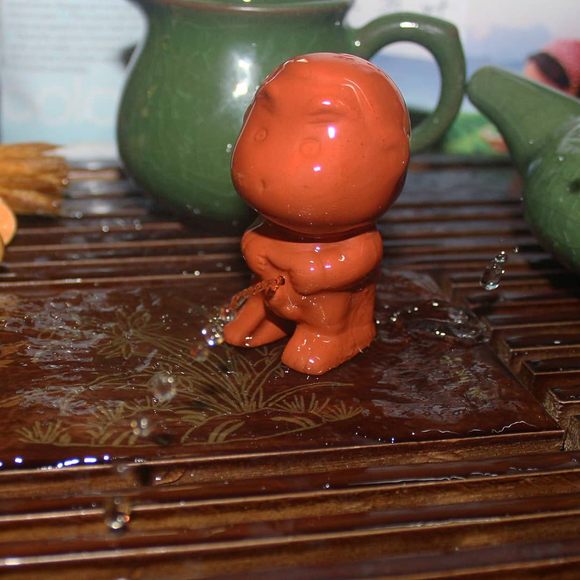References to tea drinking in China date back as far as the third century, but the evolution of one particular ritual is a bit more mysterious. Small figurines, usually made of special clay from Yixing, have become common companions to contemporary Chinese tea ceremonies (gong fu cha). Shaped like small animals, plants, or mythical creatures, the “tea pets” introduce a bit of humor to tea preparation and are part of impressing and entertaining one’s guests. Like an analog tamagotchi, tea drinkers are expected to “raise” the little objects by feeding and nurturing them. To do so, they must shower the pet in tea over the course of months, or even years, until they develop a pleasant patina and aroma from their regular tea baths.
One of China’s favorite tea pets is pee-pee boy, a hollow figurine in the shape of a child with a large head and a small penis. But pee-pee boy isn’t just a tea pet, he’s also a useful thermometer. When preparing tea, a drinker first submerges pee-pee boy, partially filling him with room temperature water (drawn in through the hole in his member), then sets him aright, usually on a tea tray. After boiling water, the preparer pours it over the figurine’s head, at which point, pee-pee boy emits a long, arcing, liquid stream, a sign that the water is hot enough for tea.
While the origins of pee-pee boy may be unclear, the physics behind his jet stream are scientifically verifiable. A 2016 study thoroughly explored the thermodynamics of several pee-pee boy figurines. The experiment revealed that when hot water is poured over pee-pee boy’s noggin, the air inside him expands, causing pressure to build and, after a few seconds, forcing a pee stream out. The hotter the poured water, the more expansion and the farther pee-pee boy’s stream. Additional factors affecting whizzing distance include head size (pee-pee boy’s cranium is disproportionately large, about and five times bigger than an adult’s) ceramic thickness, penis size, and hole diameter.
Not only are pee-pee boy’s pee-pee skills far-reaching, but researchers speculate that, if hollow ceramic figurines dating back to the Tang dynasty (618–906 CE) were also used like tea pets, that would establish them as the first thermometers, preceding Galileo Galilei’s 17th century invention of the thermoscope. While the tea pet’s provenance remains a postulation, at least one thing has been proven with certainty by the 2016 study: “Boys who pee the farthest have a large hollow head, a thin skin, and medium-size manhood.”
Written By
 Leigh ChavezBush
Leigh ChavezBush
Sources
- www.researchgate.net/figure/Graphical-representation-of-the-design-space-and-rules-of-Table-1-in-terms-of-two_fig4_305450142
- books.google.com/books/about/Science_and_Civilisation_in_China_Volume.html?id=Lx-9mS6Aa4wC
- www.researchgate.net/publication/234056375_Evidence_for_the_Use_of_Urine_Signals_in_Agonistic_Interactions_of_the_American_Lobster
- www.nature.com/articles/srep28609













